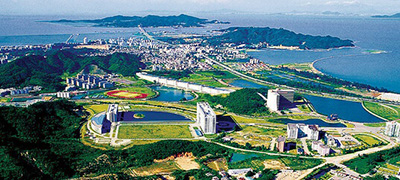A giant bureaucracy in the making?
The Greater Bay Area mustn’t become a giant bureaucracy
(Next Magazine, 2017/8/10, Second Opinion, Bill Stacey)
Integrating the Pearl River Delta to form a Greater Bay Area conurbation is founded on the compelling logic that the largest urban area in the world, with high incomes, leading manufacturing and education facilities, and a stock of accumulated human capital unmatched in any emerging market can only bring about greater prosperity. We are at the center of this and can buttress this mix with a greater degree of liberty and the rule of law.
The economic benefits of faster transport, more efficient linkages between airports, and continued regional specialization are real. Professor Richard Wong of Hong Kong University’s School of Economics and Finance has shown that our “soft skills”, not least a common law system that allows for efficient contracting and adjudication of disputes, provide the region a soft power that is world class.
Yet the Pearl River Delta is not the only region in the world to have these advantages, and we can learn from successes – and failures – elsewhere. Perhaps the greatest urban and industrial center of the last century was the Tri-State Region, which includes New York City and large parts of New Jersey and Connecticut, with a population of around 23 million. We do not need to dwell on the positives of the region, a world-class center of industry, commerce, education, and culture. However, we should learn from its mistakes.
I have visited this region for 30 years and observed at first hand its ups and downs. Right now, greater New York is in eclipse. Minor repairs to Penn Station have been billed as delivering the “summer of hell” for commuters. The tired infrastructure is showing more stress than ever. The homeless are returning to Manhattan’s streets. Shop vacancies are increasing as taxes make services and goods less competitive. Favorite diners and haunts are closing. Friends that have seemed fixtures there for decades are moving away.
Much of this comes from failures of governance. As it had evolved in the late 19th and early 20th centuries, the Tri-State Region had the best infrastructure in the world. Private companies competed and built the railway networks that linked the region as well as New York’s famous subway. The enterprising boroughs and cities of the region would compete to attract talent and business.
However, from the New Deal onwards, the role of the governments in the region grew. In the name of efficient coordination across state lines, the Port Authority of New York and New Jersey, a bureaucracy, came to own or operate much of the port, rail, road, and air transport infrastructure in the region, thus sowing the seed for its present miseries.
Bureaucratic and political management stifled commercial and economic incentives. The result is deplorable. The three states of the region all rank in the highest 10 for state tax burden, and New York is at the top of most lists. The region is beset by problems such as unfunded pension liabilities for public employees. Projects across jurisdictions have been hotbeds for corruption, delays, and union power, driving up costs.
The Greater Bay Area – and Hong Kong – should take heed by privatizing the airports, bridges, and railways owned by governments. Privatization will improve management, lower costs, and reduce the scope for corruption. The private sector will keep its assets well maintained and promote regional linkages on business terms.
The most intractable problems of the Tri-State Region come from the involvement of the Federal government, states, and unaccountable regional authorities. The Greater Bay Area should therefore encourage jurisdictional competition to foster governance. Not only is our autonomy vital, so is the ability of our neighbors to look after their own interests – region-wide authorities of any kind, with the inevitable bureaucracy – and corruption – that they entail, should be resisted at all cost.
Taxes must remain low and liberties high. The great regions of the world are created by people, not bureaucrats, and people are attracted and retained by keeping the fruits of their enterprise.
Writer: Bill Stacey
Director
The Lion Rock Institute
官僚巨人在制作中?
大灣區不可成為官僚巨人
把珠江三角洲城市整合成大灣城區,成為全球最大的城市群,當中滙集了高收入人仕、領先的制造及教育設施及人類資本的累積,這個引人注目的邏輯能帶來更大的繁榮,是其他新興市場無可匹敵的。作為這個城市群的中心,正好可以加大地運用我們的自由及法規來支撐這個組合。
快速的運輸、機場間的更高效連繫及持續成為專業地區的確是有利經濟的。香港大學經濟及金融學院 王于漸教授也表示,我們的普通法制度能有效地制訂合同及排解爭議是世界上一流的 “軟實力”。
然而珠江三角洲並非世界上唯一擁有這些優點的地方,我們更可以向其他地方成功或失敗的例子學習。紐約大都會區的三個州(以下稱紐三州),當中包括紐約市、新澤西州以及康涅狄格州,總人口達二千三百萬。這個地區都是世界級的工業、商業、教育和文化中心,我們暫且不談他的優點。但我們應該從它的錯誤中學習。
筆者在三十年前已經探訪過這個紐三州,並親見看見它的起落。現時,紐約區正在被侵蝕當中。賓夕凡尼亞州火車站的小小工程都已經能令旅客付費享用”地獄之夏”。疲勞的基建比以往壓力更大。露宿者都要返回曼克頓街頭。稅收影響產品及服務質素降低以至越來越多的空置舖位出現。最好的餐廳及駐腳點都紛紛結業。在那裡生活幾十年的朋友都在離開。
這些問題階因管治失效。過去十九世紀到二十世紀初,紐三州的基礎建設是世界數一數二的。私營企業舖設鐵路網絡並連結整個區域造就出著名的紐約鐵絡網。這樣進取的地區吸引了不少人才及企業。
然而新政推行,政府於區內的角色逐漸擴張。紐約及新澤西洲的港務局以國家路線效率之名,官僚地佔有及營運港口、鐵路、機場等基礎設施,種下了現時這個悲痛現象種子。
官僚及政治管理扼殺了商業及經濟奬勵。型成可悲的結果。紐三州區處於國家稅收負擔最高的頭十名,紐約更是名列前茅。該區受到諸如沒有資金應付公務員退休金等問題的困擾。各司法管轄區的項目都是腐敗、延誤及工會權力的溫床,從而令成本上升。
大灣區及香港應吸取這樣的經驗,把政府手上的機場、路橋及鐵路等私有化。唯有這樣才可改善管理質素,降低成本,減少腐敗的範圍。私營企業將會把資產保養良好,從而促進區內企業之聯繫。
紐三州區最棘手的問題來自聯邦政府、州政府及數之不量的地區部門。因此,大灣區應鼓勵管轄區之間的競爭來培育施政。不單是因為自治的重要,更加是為了鄰國的自身利益,這樣擴大地區化官僚及任何腐敗現象是無可避免的,我們都應不惜一切代價去阻止它發生。
只要同時維持低稅率及高自由度。世界最大的大灣區自然會由人們代替官僚建立起來,人們自然會因為企業獲得豐盛的成果而被吸引留下來。
作者:Bill Stacey
Director
翻譯:Joe Chan

